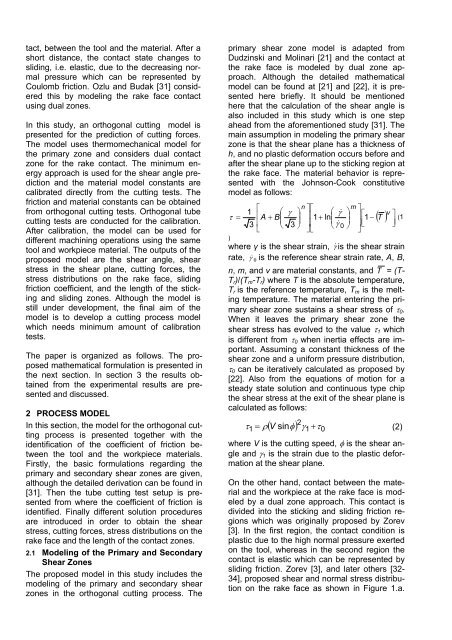t - Sabanci University Research Database
t - Sabanci University Research Database
t - Sabanci University Research Database
You also want an ePaper? Increase the reach of your titles
YUMPU automatically turns print PDFs into web optimized ePapers that Google loves.
tact, between the tool and the material. After a<br />
short distance, the contact state changes to<br />
sliding, i.e. elastic, due to the decreasing normal<br />
pressure which can be represented by<br />
Coulomb friction. Ozlu and Budak [31] considered<br />
this by modeling the rake face contact<br />
using dual zones.<br />
In this study, an orthogonal cutting model is<br />
presented for the prediction of cutting forces.<br />
The model uses thermomechanical model for<br />
the primary zone and considers dual contact<br />
zone for the rake contact. The minimum energy<br />
approach is used for the shear angle prediction<br />
and the material model constants are<br />
calibrated directly from the cutting tests. The<br />
friction and material constants can be obtained<br />
from orthogonal cutting tests. Orthogonal tube<br />
cutting tests are conducted for the calibration.<br />
After calibration, the model can be used for<br />
different machining operations using the same<br />
tool and workpiece material. The outputs of the<br />
proposed model are the shear angle, shear<br />
stress in the shear plane, cutting forces, the<br />
stress distributions on the rake face, sliding<br />
friction coefficient, and the length of the sticking<br />
and sliding zones. Although the model is<br />
still under development, the final aim of the<br />
model is to develop a cutting process model<br />
which needs minimum amount of calibration<br />
tests.<br />
The paper is organized as follows. The proposed<br />
mathematical formulation is presented in<br />
the next section. In section 3 the results obtained<br />
from the experimental results are presented<br />
and discussed.<br />
2 PROCESS MODEL<br />
In this section, the model for the orthogonal cutting<br />
process is presented together with the<br />
identification of the coefficient of friction between<br />
the tool and the workpiece materials.<br />
Firstly, the basic formulations regarding the<br />
primary and secondary shear zones are given,<br />
although the detailed derivation can be found in<br />
[31]. Then the tube cutting test setup is presented<br />
from where the coefficient of friction is<br />
identified. Finally different solution procedures<br />
are introduced in order to obtain the shear<br />
stress, cutting forces, stress distributions on the<br />
rake face and the length of the contact zones.<br />
2.1 Modeling of the Primary and Secondary<br />
Shear Zones<br />
The proposed model in this study includes the<br />
modeling of the primary and secondary shear<br />
zones in the orthogonal cutting process. The<br />
primary shear zone model is adapted from<br />
Dudzinski and Molinari [21] and the contact at<br />
the rake face is modeled by dual zone approach.<br />
Although the detailed mathematical<br />
model can be found at [21] and [22], it is presented<br />
here briefly. It should be mentioned<br />
here that the calculation of the shear angle is<br />
also included in this study which is one step<br />
ahead from the aforementioned study [31]. The<br />
main assumption in modeling the primary shear<br />
zone is that the shear plane has a thickness of<br />
h, and no plastic deformation occurs before and<br />
after the shear plane up to the sticking region at<br />
the rake face. The material behavior is represented<br />
with the Johnson-Cook constitutive<br />
model as follows:<br />
( ) ⎤ ⎡<br />
⎡<br />
n ⎤⎡<br />
m<br />
⎛ ⎞<br />
⎤<br />
1 ⎛ ⎞<br />
v<br />
⎢<br />
γ �<br />
⎥⎢<br />
γ<br />
⎥<br />
⎢⎣ ⎥⎦<br />
−<br />
τ = A + B +<br />
⎢ ⎜<br />
⎟<br />
⎢ ⎜<br />
⎟ 1 ln 1 T (1<br />
3 ⎥<br />
⎥<br />
⎣<br />
⎝ 3 ⎠<br />
⎦⎣<br />
⎝ � γ 0 ⎠<br />
⎦<br />
)<br />
where γ is the shear strain, γ�is the shear strain<br />
rate, γ� 0 is the reference shear strain rate, A, B,<br />
n, m, and v are material constants, and T = (T-<br />
Tr)/(Tm-Tr) where T is the absolute temperature,<br />
Tr is the reference temperature, Tm is the melting<br />
temperature. The material entering the primary<br />
shear zone sustains a shear stress of τ0.<br />
When it leaves the primary shear zone the<br />
shear stress has evolved to the value τ1 which<br />
is different from τ0 when inertia effects are important.<br />
Assuming a constant thickness of the<br />
shear zone and a uniform pressure distribution,<br />
τ0 can be iteratively calculated as proposed by<br />
[22]. Also from the equations of motion for a<br />
steady state solution and continuous type chip<br />
the shear stress at the exit of the shear plane is<br />
calculated as follows:<br />
2 ( φ)<br />
γ1<br />
0<br />
τ = V +<br />
(2)<br />
1 ρ sin τ<br />
where V is the cutting speed, φ is the shear angle<br />
and γ1 is the strain due to the plastic deformation<br />
at the shear plane.<br />
On the other hand, contact between the material<br />
and the workpiece at the rake face is modeled<br />
by a dual zone approach. This contact is<br />
divided into the sticking and sliding friction regions<br />
which was originally proposed by Zorev<br />
[3]. In the first region, the contact condition is<br />
plastic due to the high normal pressure exerted<br />
on the tool, whereas in the second region the<br />
contact is elastic which can be represented by<br />
sliding friction. Zorev [3], and later others [32-<br />
34], proposed shear and normal stress distribution<br />
on the rake face as shown in Figure 1.a.









